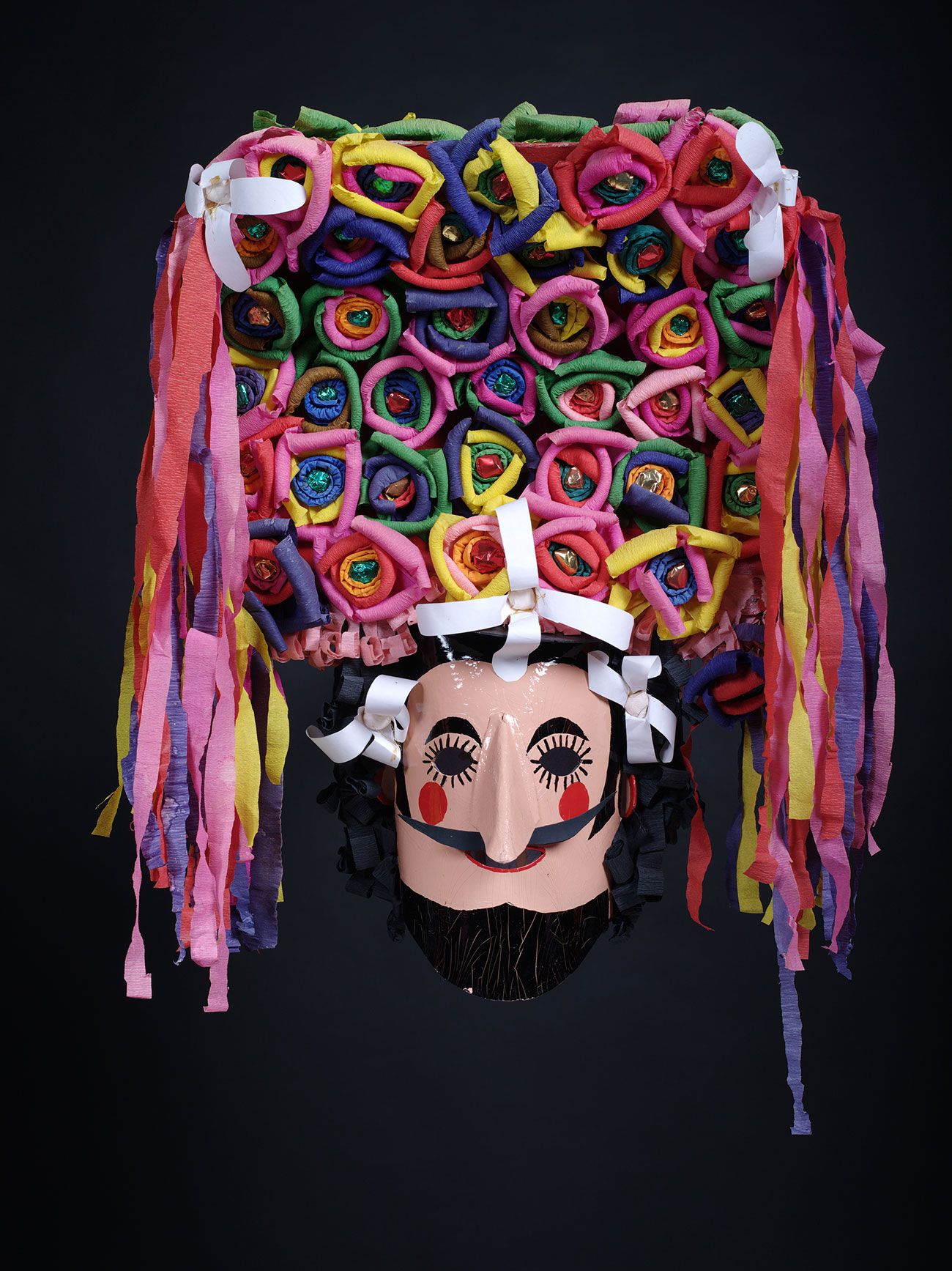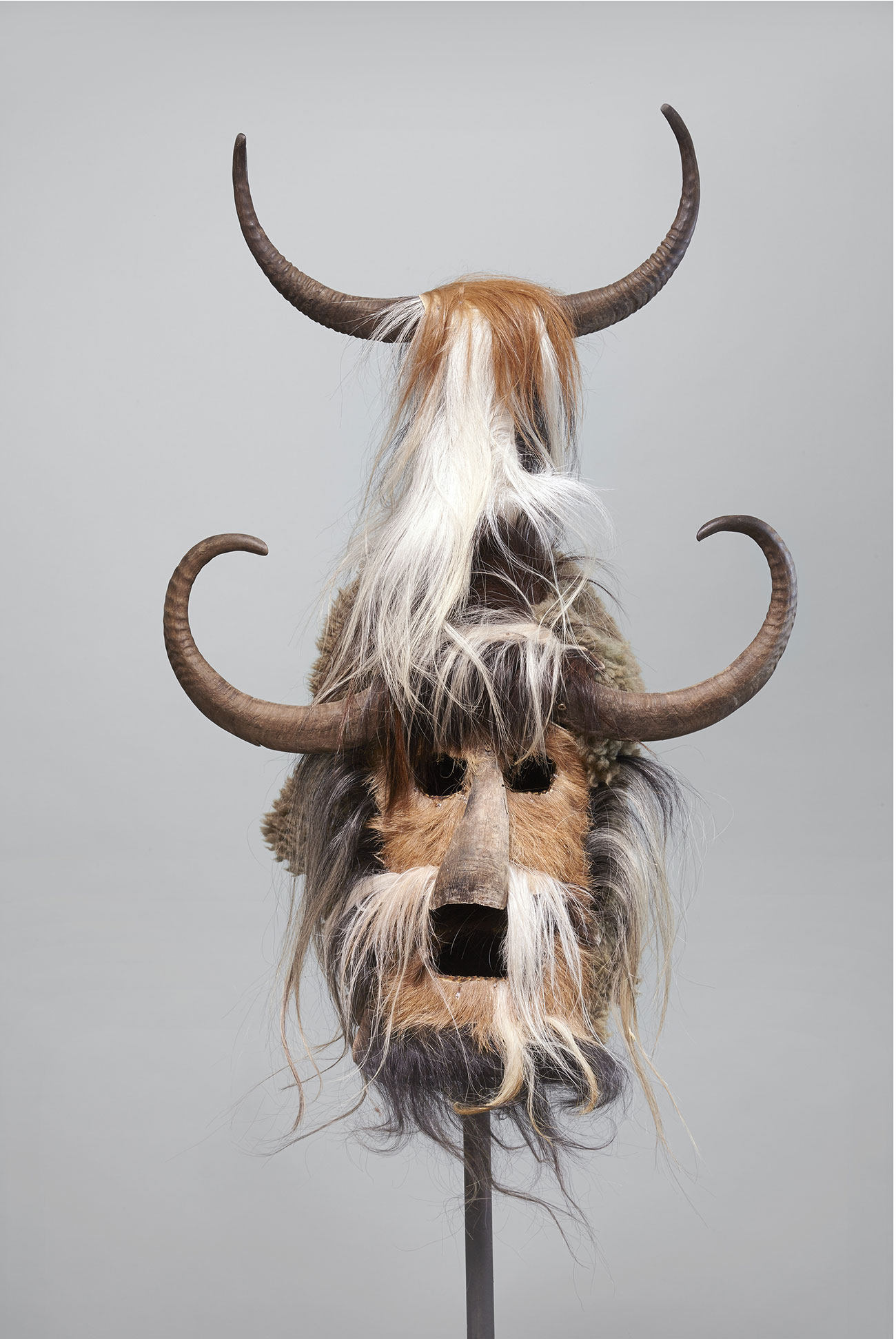The topsy-turvy world
Carnivals and masquerades in Europe and the Mediterranean
|
From Wednesday 26 March 2014 to Monday 25 August 2014
In the 1960s, it was thought that one could predict the death of the carnival, reduced to a childish party or a folkloric show. In the end, this is not the case. Fifty years later, the carnival is doing quite well. Everywhere, rural masquerades and urban parades are reborn and reinvented, seeking to reconnect with ancient rites or taking inspiration from forms returning from far away.
The phenomenon has become so widespread that the Mucem engaged in a “survey-collection” initially intended to enrich its collections. Given the quality of the search results, it was decided to organise an exhibition entitled “The Topsy-Turvy World” devoted to contemporary carnivalesque practices.
What is the carnival?
Today very different events are grouped under this name :
— Urban parades, linked or not to the liturgical calendar, ancient or recently invented.
— Ritual masquerades of winter, sometimes starting with All Saints’ Day, characterise the 12-day period, Epiphany or “fat days” before lent. Revisited, these masked rites are now experiencing a widespread resurgence.
— Tropical carnivals enjoy worldwide success. They fascinate the Europeans who go there and are practiced in Europe as celebrations of identity by immigrants originating from the Caribbean or South America.
— Masked rites of the southern shore of the Mediterranean: masquerades of Eid-al-Kabir and Ashura in the Berberspeaking areas of Morocco, Berber New Year (Yennayer) in Kabyle-speaking Algeria, Jewish Purim. The Berber masquerades integrated into the Islamic lunar calendar are now experiencing a revival as pre-Islamic Berber celebrations and are sometimes transformed into urban carnivals, as in Inezgane, in the region of Agadir. Like the parades of Purim in Israel, the current Moroccan carnivals are part of the global carnival culture, which mixes transgressive behaviour, street art, assertions of identity and the jubilation of participating in the celebration.
So diverse at first glance, these events have much in common: archetypical characters, found both in cities and the countryside, reoccurring behaviour (overeating, sexual license and scatology, inversions of all kinds, the use of masks to reveal misconducts and to critique local or international politics), but especially the common representations of the celebration. The liberty of the carnival, its transgressions, its game of masks, its impertinence, its capacity to stage the diverse social components, so often polemic, yet belonging to a common fund, recognised by all.
The carnival appears today as a culture common to the societies of the Euro-Mediterranean area and to those who are partially its descendants, a very old substrate, made of reciprocal borrowing and intermixing. Most “carnivalists” understand that it is a celebration widespread throughout time and space, even if they participate primarily to exercise membership in their communities. Experienced at once as a celebration of identity and yet still universal, the carnival, through its game of masks and unveiling, speaks to us of contemporary societies.
General Commissioner: Marie-Pascale Mallé
Associate Commissioners: Françoise Dallemagne, Frédéric Mougenot
Scenography: Massimo Quendolo et Léa Saïto
Co-production venue: Musée International du Carnaval et du Masque in Binche (Belgium), in partnership with Mons 2015, European Capital of Culture
[This exhibition will be presented at MICM in Binche in an abbreviated form (800 m²) from late January to late June 2015]
Exhibition itinerary
The exhibition "The Topsy-turvy world"
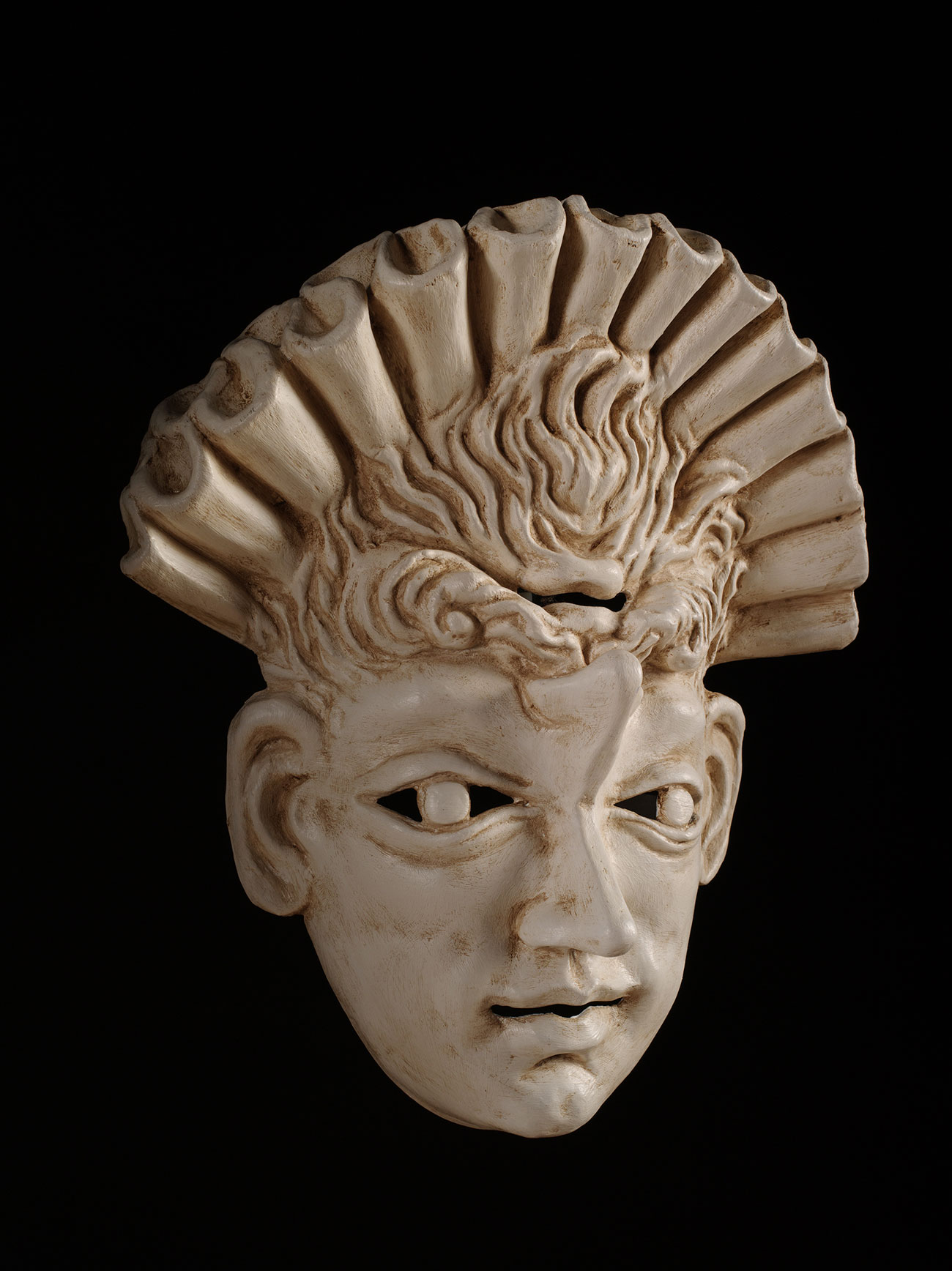
There are many ways to envision an exhibition on the carnival, especially around the mask, the costume, the collective madness, by offering a historical and typological description of the different celebrations or an even more technical approach to the street arts and the expertise developed by carnivalists as by individuals, who give free rein to their imagination in the confection of costumes and the preparation of floats. The exhibition “The Topsy-Turvy World” develops another perspective. Indeed, after having surveyed from 2008 to 2012 terrains as diverse as the masquerades of the Pyrenees or the Balkans and the urban carnivals of Cayenne, Dunkirk or Notting Hill, it appears that the richness of current carnivalesque practices follows on existing representations.
One of the main reasons for the current renaissance in carnivals and masquerades is the fascination exercised upon an audience in search of meaning and authenticity, the archaic characters of the carnivalesque scene. Everywhere, rural masquerades and carnivals called “traditional” or “historical” are reviving, relying occasionally on the writings of ethnologists or folklorists from the late 19th century. Actors and spectators evoke the need to perpetuate an “ancestral” ritual of their own community, even if it is largely reinvented.
The exhibition “The Topsy-Turvy World” thus invites us on a voyage into the carnivalesque imagination. The itinerary includes powerful and jubilatory moments of immersion and time for reflection on what this celebration teaches us about contemporary societies and ourselves.
First Section: The masks of winter or the cyclical regeneration of the world
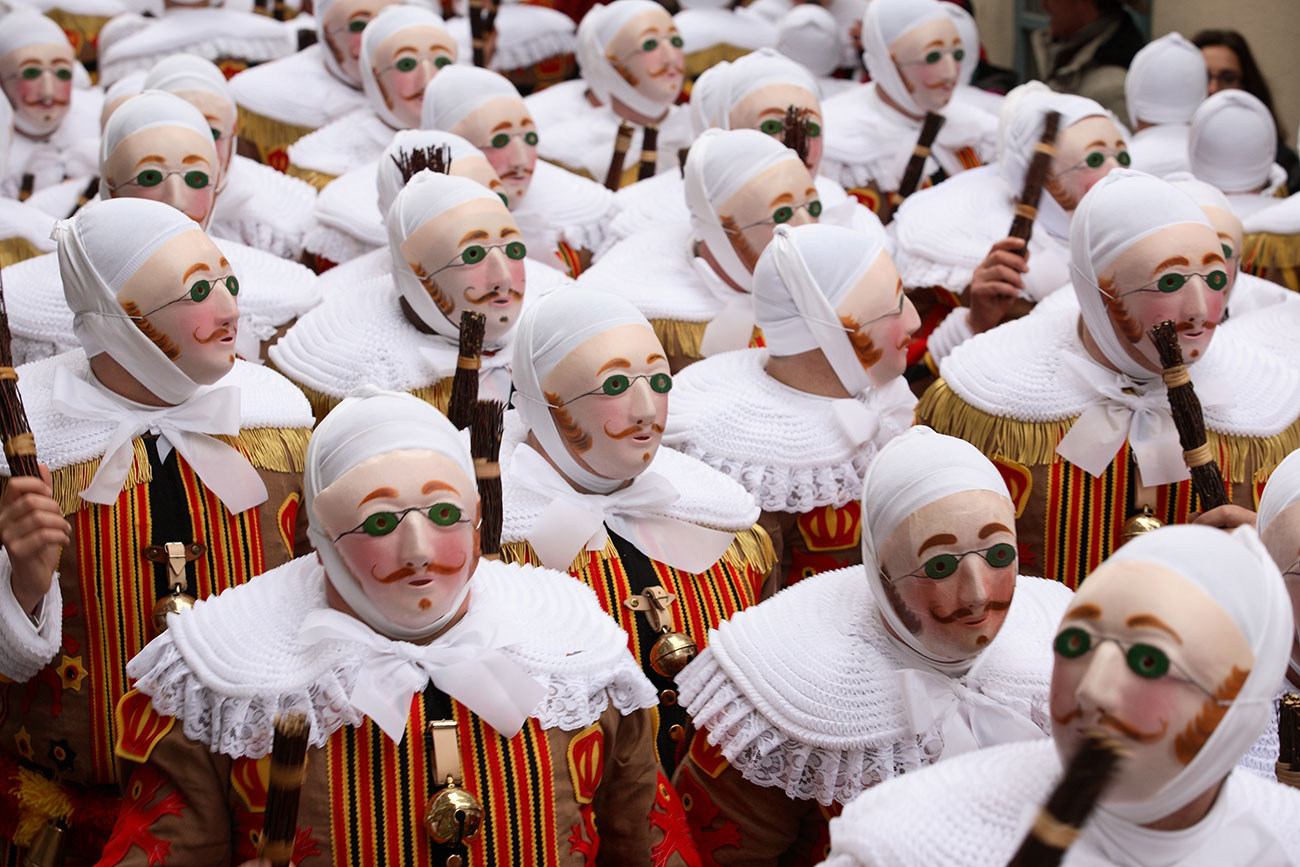
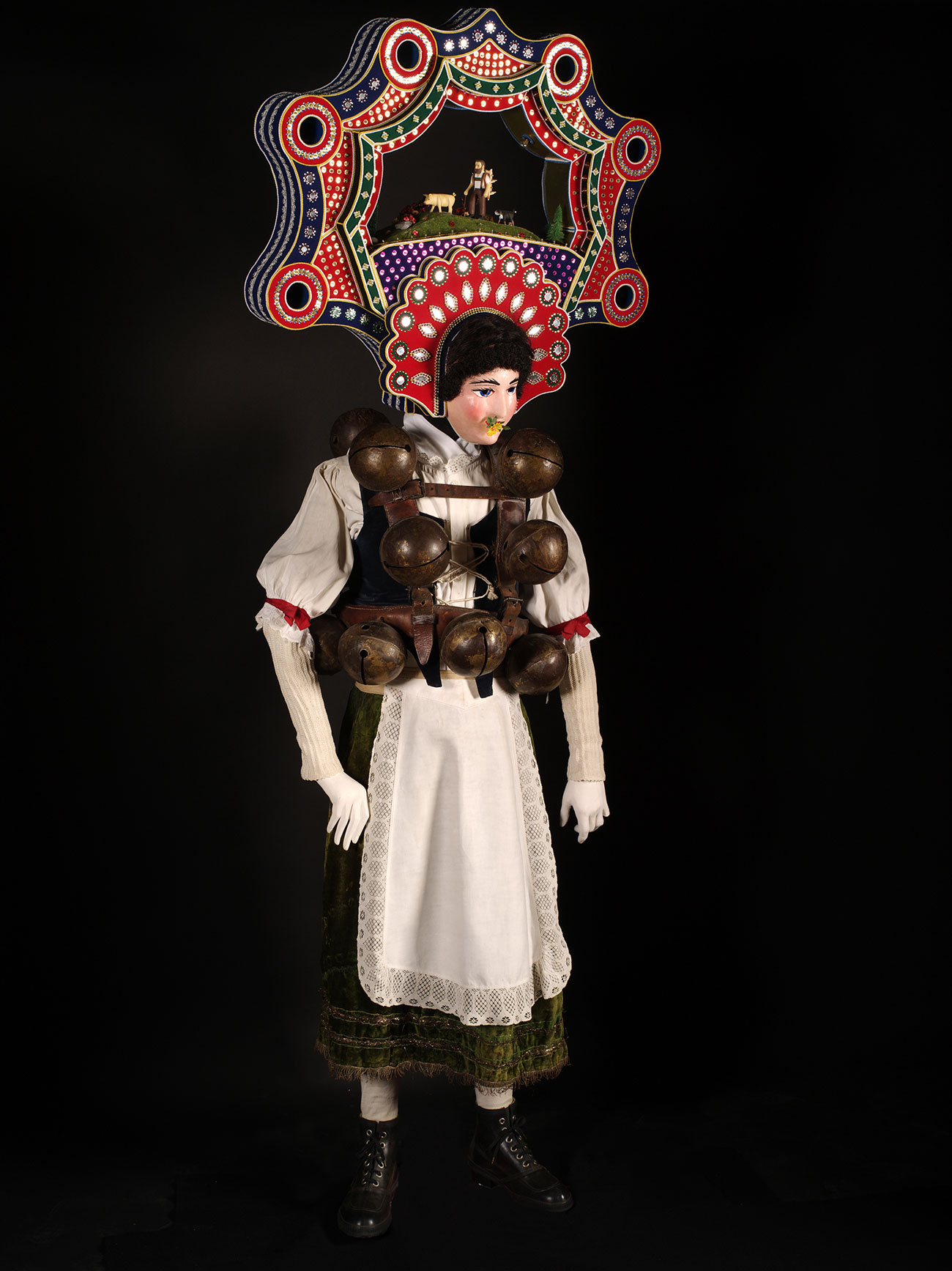
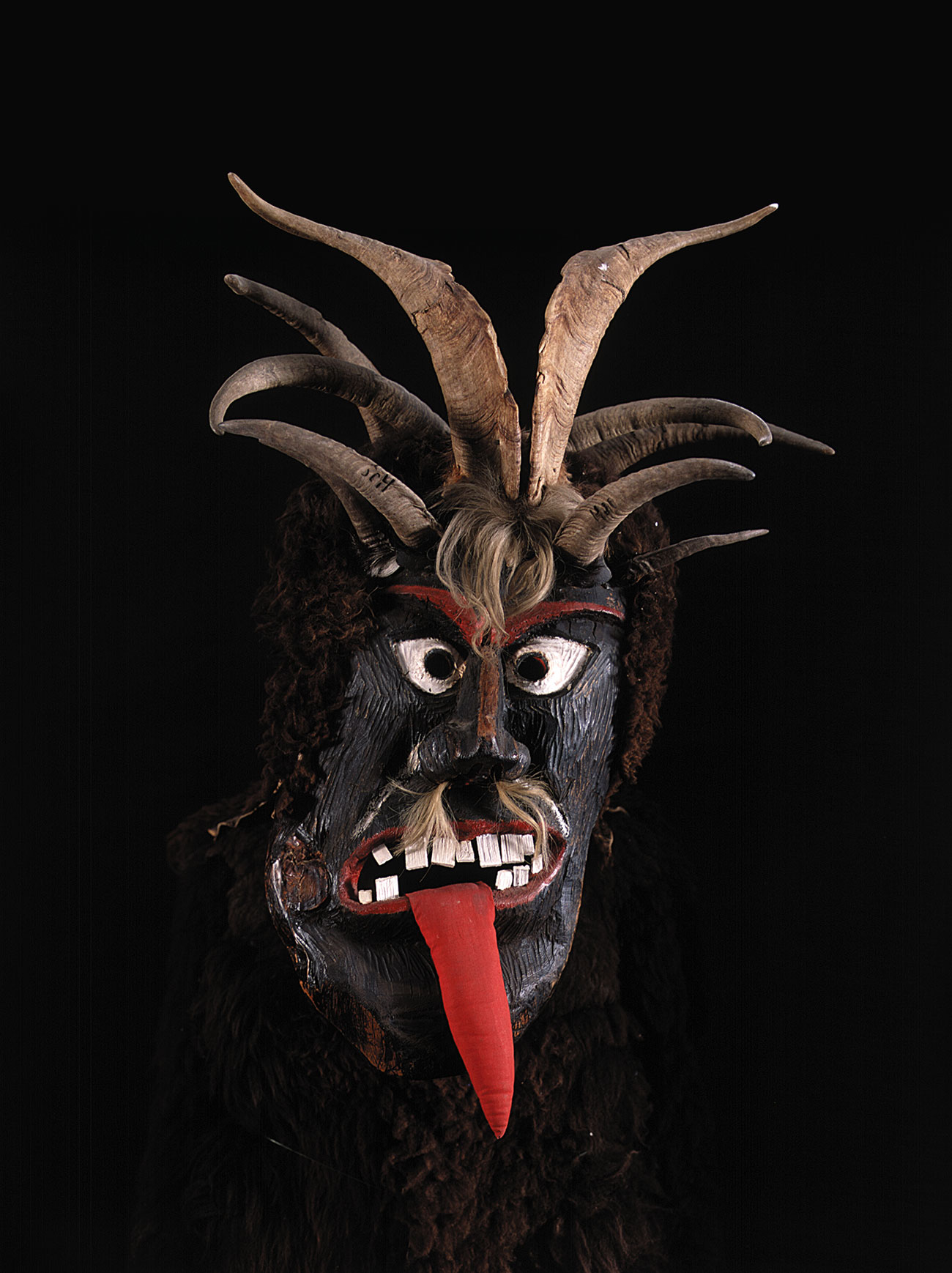
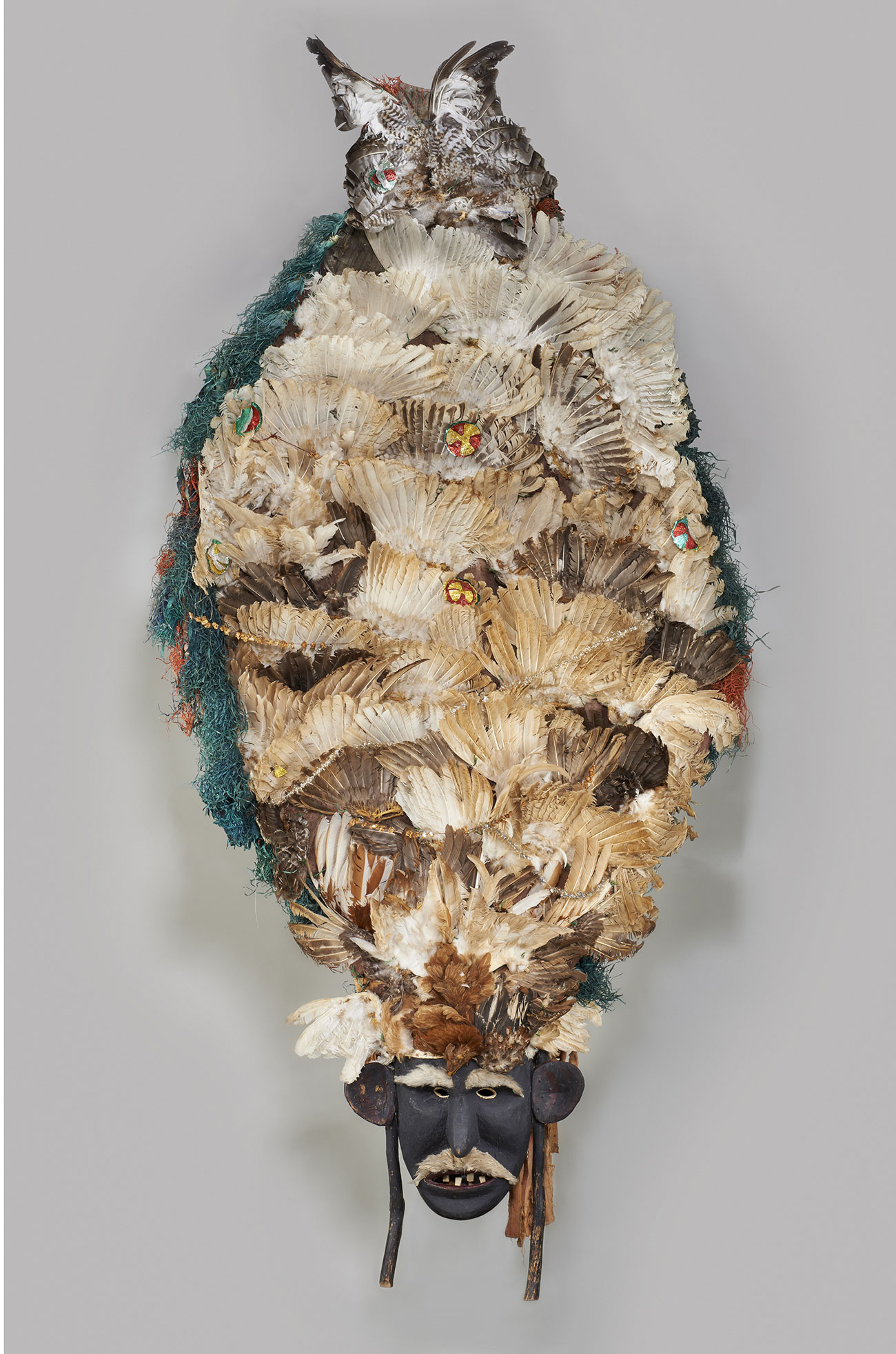
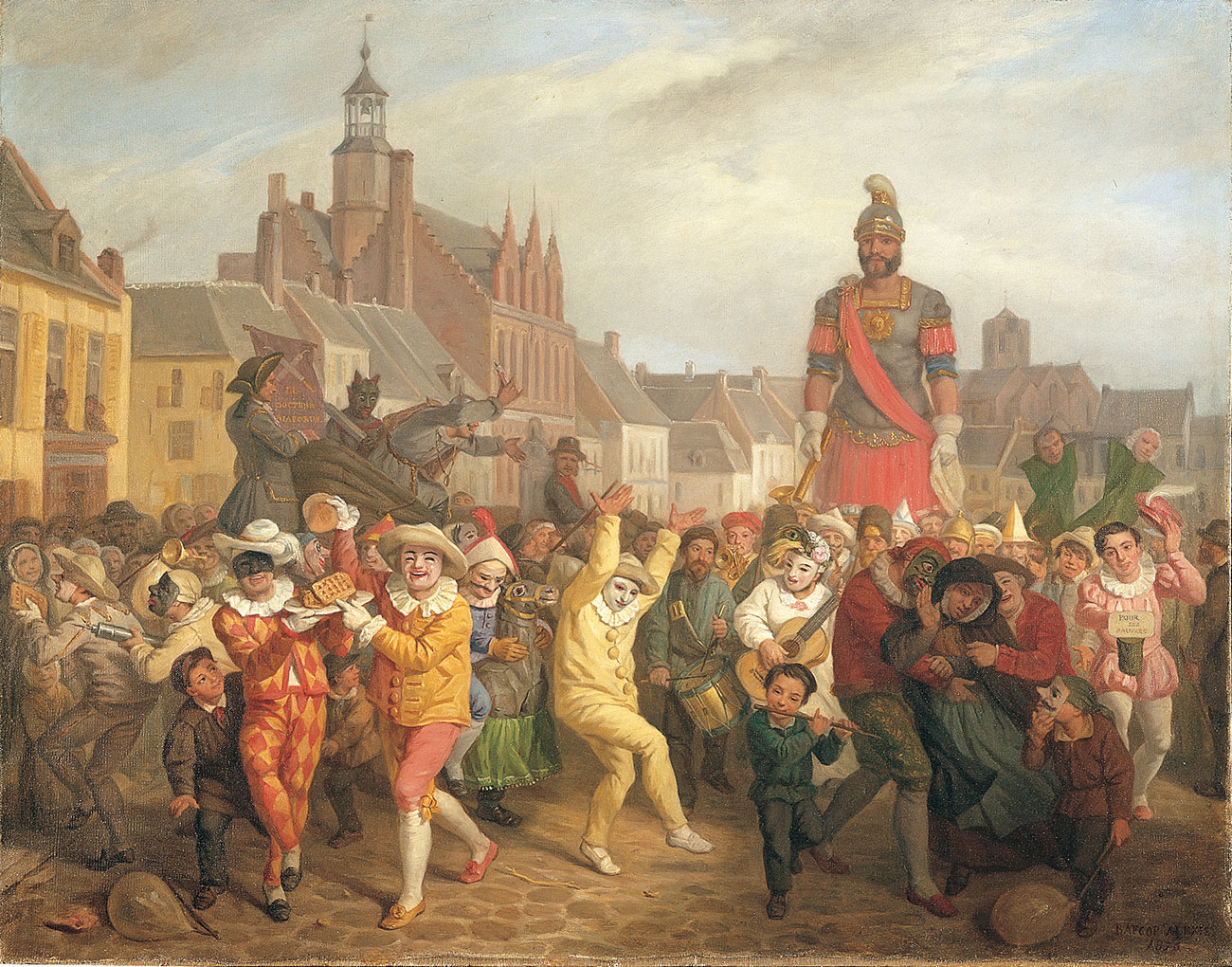
The folklorists and anthropologists from the early 20th century have often described the carnival as a ritual of agrarian magic. The carnivalists of today are reappropriating these interpretations. In the city as in the countryside, the carnival is always experienced as a celebration of renewal.
Even if they seem immemorial, the practices described in this first section are performed by participants perfectly integrated into modern life, which they have partly reinterpreted.
The bell ringers
Traditional societies create a hullabaloo each time that the natural or social order seems threatened: eclipses of the sun, the changing of the year or on the occasion of illsuited marriages. Still today, the racket and the uproar accompany protest demonstrations.
The hullabaloo evokes the original din which presided at the creation of the world and is thus vital to its rebuilding, the return to order. It is a universal component of carnivals, often the privilege of the bell ringers, these curious characters that we encounter from Morocco to Georgia and from Germany to Iran. To drive away winter, to expel the forces of evil, sweeping away the mistakes and misunderstandings of the past year, reviving the vegetation, hastening the arrival of spring, calling for prosperity and harmony in the year to come. Such are their
missions.
The first hall, with immersive and sonorous scenography, places visitors in the shoes of the populations of cities and villages confronted by the arrival and take over of the masked carnivalists. The goal is immediate astonishment by presenting a vision of the carnival other than that which they know, to stimulate their curiosity about the archaic aspects of the festival, preparing them for images that may seem shocking or vulgar outside the context of the carnival.
The iconic figure of the bell ringer is presented in an array of costumes coming from all-over the Euro-Mediterranean and from recently produced films. But while the character of the bell ringer is universal, the dates on which they appear vary considerably, this is explained by the coexistence and the superimposing of different calendars: popular, official and liturgical.
The time portal
Everywhere, the carnival is a well-defined period, whose beginning and end are officially proclaimed, but whose dates and duration are highly variable. The structure entitled “the time portal” poetically evokes the relationships of the carnival to time and the calendars and invites visitors into the “fifth season”. This is what they so nicely call the carnival in German-speaking areas. People of the early 21st century live in different times and their actions adhere to different calendars: lunar and solar, official and popular, Gregorian and Julian, agrarian or liturgical, ancient Celtic calendars, Slavic, or Hebrew.
The carnival raises another idea of time and the seasons than the official calendar; it is a cyclical vision of time, associated with ancient beliefs: on the one hand, the need to contribute to the regeneration of the world, worn out by the end, in order to ensure the prosperity of the new year; which includes the convocation of the ancestors, the souls of the dead, depositories of the powers of fertility for the community; on the other hand, the belief that this passage is a space of non-time, where the world is out of whack and where hell opens up, liberating the demons and the forces of evil.
The carnival is a propitiatory rite of the changing of the year intimately linked to a cult of the dead.
An agrarian rite
Despite the revivals and reinventions visitors will be surprised by the similarities and the convergences between all the carnivals of the Euro-Mediterranean area. Everywhere, we find the same characters, the same gestures. Everywhere the masked armed with brooms to chase away winter and make a clean sweep for the new year; everywhere we adorn hats with flowers, ribbons, and mirrors to seduce the springtime; everywhere we mock and we celebrate human sexuality; everywhere animal masks provide vitality, fertility, fecundity. Just like the carnival king, condemned, executed, but who will be reborn the following year, they symbolise, through their games of death and resurrection, the victory of life over death.
In this second hall, we will play upon the accumulations of objects, in order to deconstruct the rituals, and on the films in order to demonstrate both the contemporary character of the practices and their universality, but without too much distance, as to sense the fervour and the adhesion of the festival actors to their roles.
Ancestors, the Devil and Death
A celebration of life and renewal, the carnival is inextricably linked to death. The medieval feast of fools was organised by the fraternities of souls in purgatory. Today many carnivals still begin with a mass for the dead and a visit to the cemetery. In the form of the Grim Reaper or a skeleton,
Death, often accompanied by the Devil, haunts parades and masquerades. Masks themselves embody the spirits coming from the land of the dead, ancestors, and also contribute to sending them back.
A diabolical procession of devils, witches, and phantoms from the different regions of the Euro-Mediterranean space makes visitors aware of this dimension of the carnival.
In the mirrors of interpretations
Après avoir démontré l’universalité de certains personnages et de certaines pratiques, l’exposition interroge la définition et les origines de la fête carnavalesque en s’appuyant sur des objets archéologiques, des tableaux ou des gravures qui dialoguent avec des objets carnavalesques. Il ne s'agit pas de donner une réponse scientifique, de trancher définitivement le débat sur les origines du carnaval, mais de présenter chacune des hypothèses évoquées comme autant de miroirs où nous croyons et souhaitons nous reconnaître.
Dans l'Europe occidentale catholique, le carnaval est considéré comme le pendant du Carême, une période de liesse et d'abondance avant le long jeûne qui précède Pâques. Personnification d'une période de l'année et plus encore d'une manière de vivre, le carnaval a-t-il été inventé par l'Eglise comme pendant du sacrifice et du jeûne ou bien est-ce une « survivance païenne » que l'Eglise a canalisée en l'intégrant à l'année liturgique ? Que nous souhaitions voir dans le carnaval un héritage des Dionysies grecques ou des Lupercales romaines, une très ancienne tradition celte, germanique ou berbère ou encore le plus ancien rituel indo-européen, éclaire l'idée que nous nous faisons de notre identité.
Second Section: To hide or to reveal? The power of masks
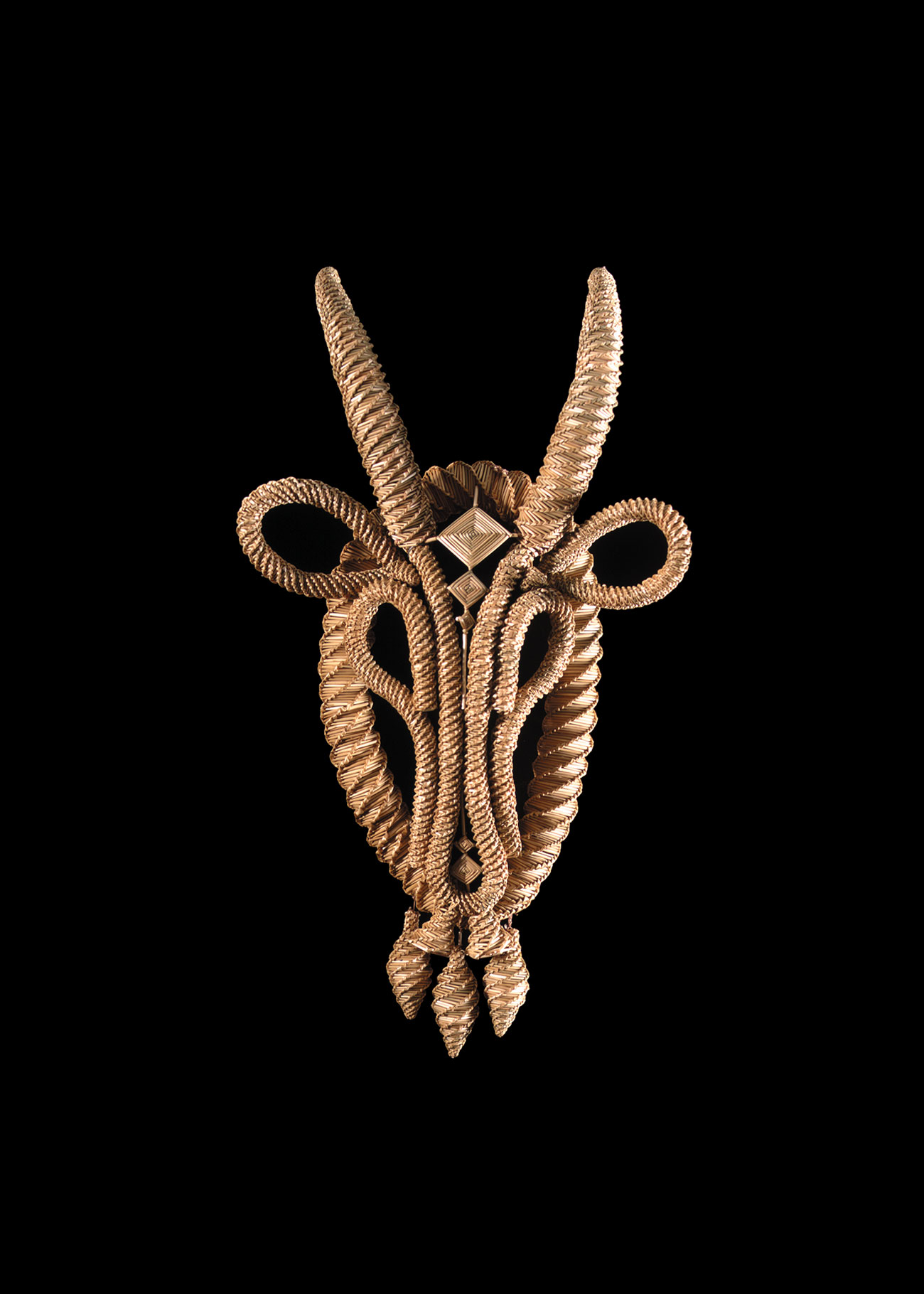
In old French as in Italian, the word “mask” designates the entire costume and by extension the character. But the object that hides or replaces the face remains the most intriguing. The mask conceals and reveals. It displays our secret self and transcends the frontier of appearances.
When are we more ourselves? Under the social mask of daily life or behind the carnival mask, which provides the freedom of anonymity and gives free rein to our impulses?
Behind the mask
Visitors are welcomed to this section by an ensemble of accounts by the “masked” that capture the emotion and the fervour of the carnival actors and raise questions about the relationship of the spectator, like the wearer, to the mask, questions of being and appearance, character and person.
The heritage
Since Antiquity, in funeral ceremonies or the theatre, the mask was used as a substitute face. It makes the common and the mortal disappear replacing them with the powerful or the extraordinary. This transformation itself is more effective than the object fascinating or frightening. Thus, in the ornamentation, scholarly or popular, the human face like the mask wards off evil. Funerary, theatrical and prophylactic masks will illustrate the long history of masks in the Mediterranean.
Masks off
A wide variety of carnival masks are presented in this part of the exhibition in order to raise awareness of the extraordinaire richness and variety of this heritage throughout the Euro- Mediterranean area: masks made of wood, bark, fabric, metal, paper mache, testify to the importance and the permanence of masked rituals in all the countries of this part of the world.
Third Section: Following the parade: the celebration turned upside down or the domain of ambivalence?
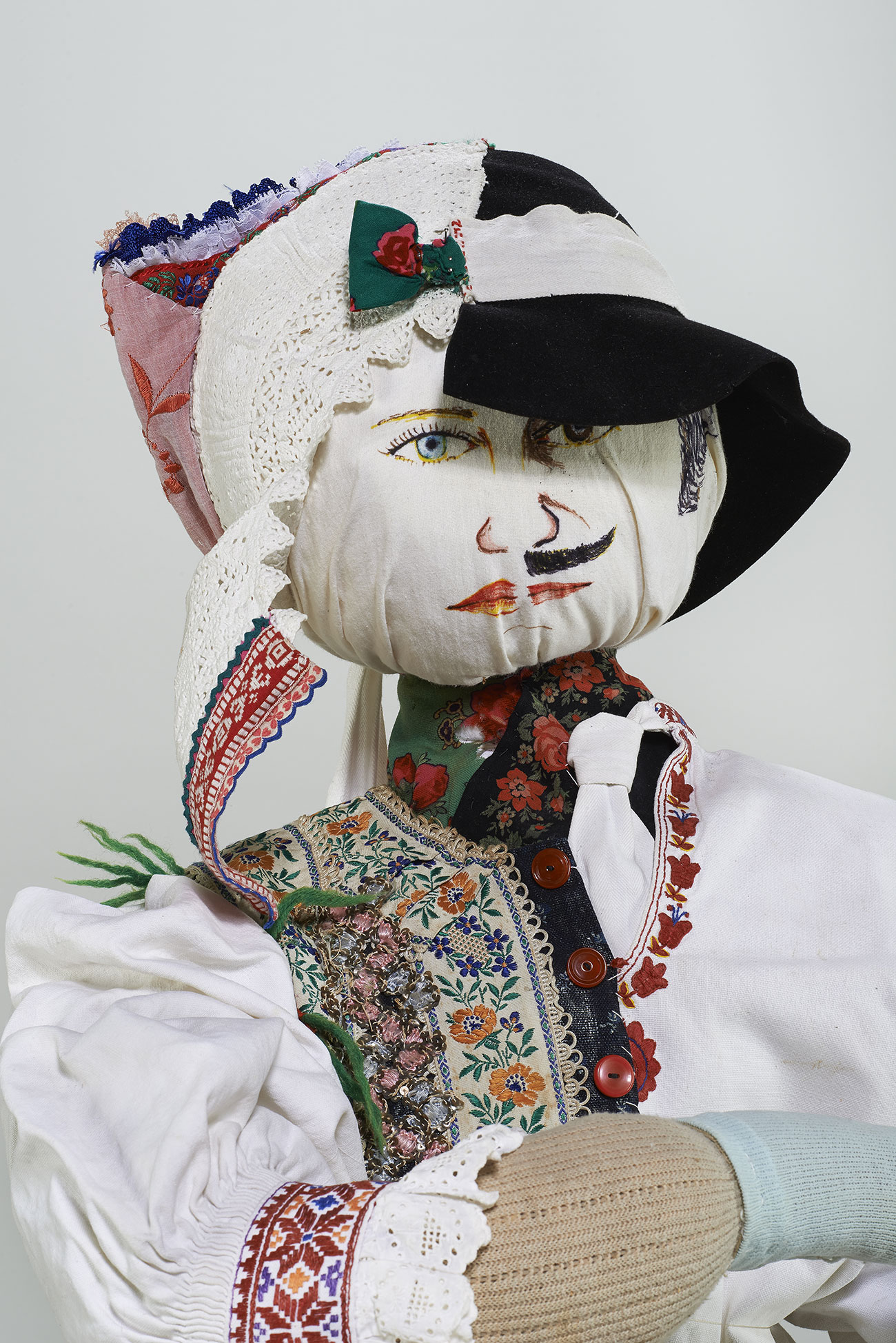
This section addresses another function of the carnival: the regeneration of the social order. It is presented in the form of a parade; visitors find themselves in the role of spectators following the procession. The grouping of characters by theme, in dialogue with the iconography or the objects placed opposite, encourages awareness of the signification of specific carnivalesque staging.
Us and the others
The battle of opposites, the reversal of the sexes, masters and slaves, savage and civilised, loved ones and strangers are at the heart of carnivalesque games. We can also explore the element of madness, the brute, sexual ambiguity which is in itself, to represent the other with all the ambivalence of sentiments that it inspires in us, to be an “other” for a few hours or days.
More specifically the carnival invites us to redefine who we are and, through the staging of otherness, to recognise each other. The costumes of “strangers” are universal: savages, marginalised populations such as itinerants, gypsies, Jews or even exotic foreigners like the Moors or Turks, portrayed like soldiers armed with swords or princes from the Orient, opulent and refined.
Young or old, dwarfs or giants, men or women: the grotesque body
Le corps en devenir, le corps ambigu, le corps difforme … La transgression grotesque, qui relativise et malmène les règles d’harmonie et de mesure traditionnellement admises, est propre au vocabulaire carnavalesque. Géants, grosses têtes, travestissements d’hommes en femmes, masques grimaçants illustrent cet aspect bien connu du carnaval
From the carnival to the carnivalesque: the great hullabaloo
The rebuilding of the social order invites us to redefine who we are but also to make a place to clear away all the dissension, all the mistakes of the past year. To reveal the misconducts of one another, criticise local, regional or international politics, staging contemporary fears in order to exorcise them: from the court of laughter of the village carnivals to the great parades of floats in Cologne and Viareggio, from derision to protest demonstration, carnivalesque language is at the service of social and political critique. Alongside the caricature of politicians and the denunciation of scandals, small and large, the economic and financial crisis is a source of endless inspiration, as demonstrated here by the floats and costumes acquired from recent parades.
This section entices visitors from the carnival to the carnivalesque, a mode of popular expression that extends the practice of hullabaloo, the specific language of the protest, and infects other types of urban festivals, student or union demonstrations, stadiums or gay-pride.
Dreams of elsewhere
Carnivals around the world are now tourist destinations. In search of new emotions, Europeans frequent tropical and South American carnivals adopting the rhythms, the feathers and glitter; immigrants from these countries import them into Europe as symbols of their culture. The costumes of a young Belgian participant in the Rio carnival and those of the blonde samba dancers from Helsinki illustrate these exchanges and the globalisation of the carnival.
More precious and secret, the carnival of Venice always fascinates and also allows us to escape, not in space but in history. The association of Masked Venetians of France is loaning to the Mucem for the occasion of this exhibition the costumes that their members create to live out their dreams.
After having crossed the burning of the Bonhomme Carnaval, it is time to return to the real world, right side up.
